HomeStream
News & more!Escapes
My trip reviewsGallery
My travel photosPlanning
Trip planningGuides
Destination guides
My Escapes  Greece
Greece  Greek Week
Greek Week  Meteora
Meteora  Meteora, Kalambaka, Kastraki
Meteora, Kalambaka, Kastraki  Guide to the Meteora Monasteries
Guide to the Meteora Monasteries
Guide to the Meteora Monasteries
One of the highlights of visiting Greece is in fact Meteora: the renowned ancient monasteries built on top of majestic rounded cliffs.
Should you travel to Greece, I advise you not to leave Meteora out!
Meteora is definitely worth visiting and staying at least 2 full days in a nearby town.
I chose Kalambaka town as my base and I stayed 2 full days... and a few more hours on my first day. Arrived in by train directly from Athens' Larissis Train Station. Shaky 5+ hours on a low-tech train...
Meteora is a magical place - visit it for the stunning views, for the historic heritage (the monasteries built atop the cliffs) and delicious Greek food!
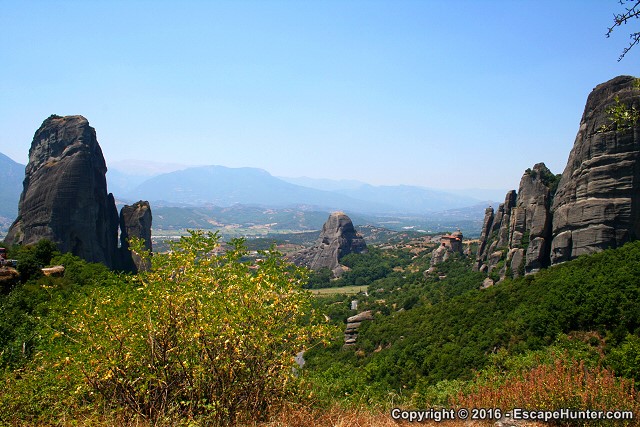
View Photo Gallery for more travel photos
Nonetheless, the ancient Greek Orthodox monasteries built at the top of cliffs should be your primary focus when arriving to this surreal place.
Additionally, you can check out the nearby towns, have a few meals at local restaurants. I did try a few specialities and have enjoyed Greek cuisine quite a lot!
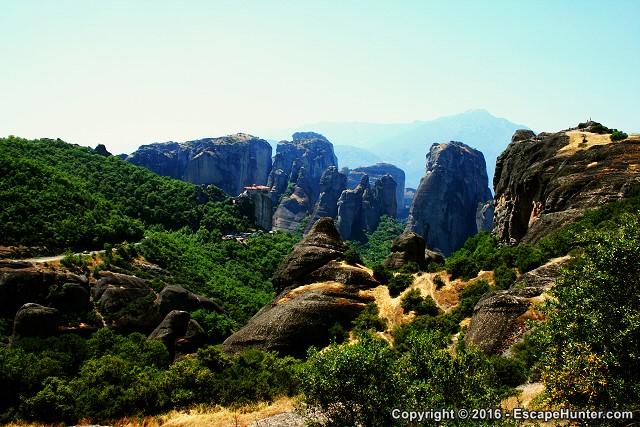
Test: find Rousanou Monastery in this picture!
View Photo Gallery for more travel photos
A Meteora day trip won't do the job, stay at least 2 full days. Trust me!
The Great Meteoron, Varlaam, Rousanou, Agios Nikolaos Anapafsas, Agias Trias (Holy Trinity), Agios Stefanos (Saint Stephen) are the monasteries open for visitors.
A handful of other monasteries and churches (which can be depicted on many maps) are not open to the public...
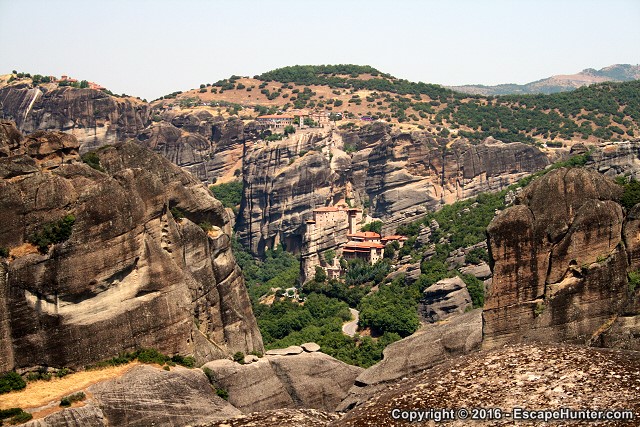
View from Agias Trias: Great Meteoron, Varlaam and Rousanou monasteries (left to right)
View Photo Gallery for more travel photos
The monasteries are found scattered across challenging terrain, but hiking is not required. Unless you're into it. (I did in fact hike to Agios Trias on a forest trail from Kalambaka).
Get a map and plan your itinerary. All these monasteries are easily reached by road couppled with a short walk. They are not as remote as they were 400-500 years ago!
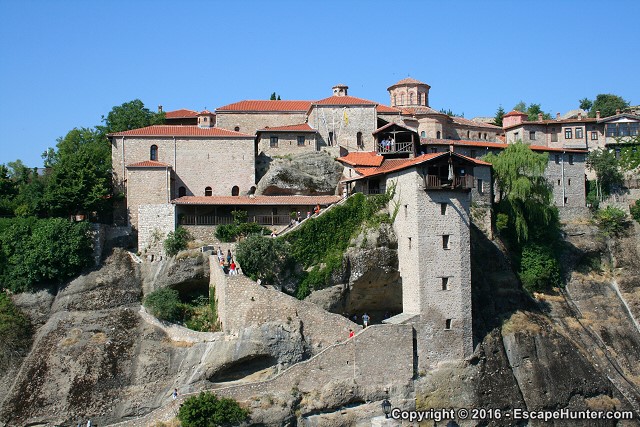
Great Meteoron monastery
View Photo Gallery for more travel photos
On a typical summer day, you will find the monasteries jam-packed with common tourists, families... it gets crowded, noisy even. And hot...
You'd want to start off visiting well before noon (ideally early in the morning) from the most high-situated Great Meteoron - I simply took a taxi and descended along the road on my own two feet.
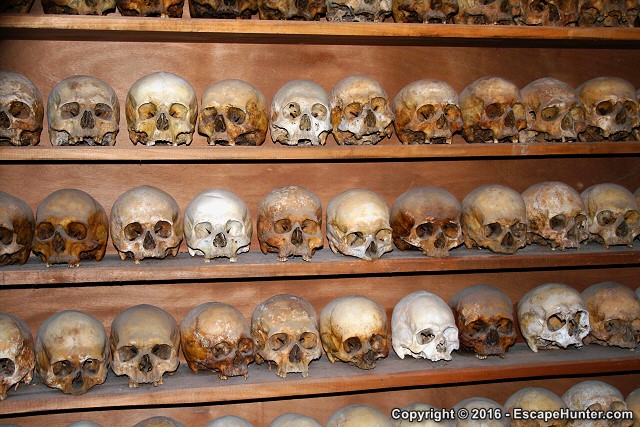
The skulls of monks who lived in the monastery. Notice the missing jaws! Creepy and disgusting.
View Photo Gallery for more travel photos
Each monastery is unique, all of the ones I mention here are worth seeing. But if your time is pressuring you, then at least visit the two following: Great Meteoron and Rousanou. To me, these two stood out.
In addition to the interiors and the architecture of the monasteries themselves, I would also underline the enjoyable surreal views from up there.
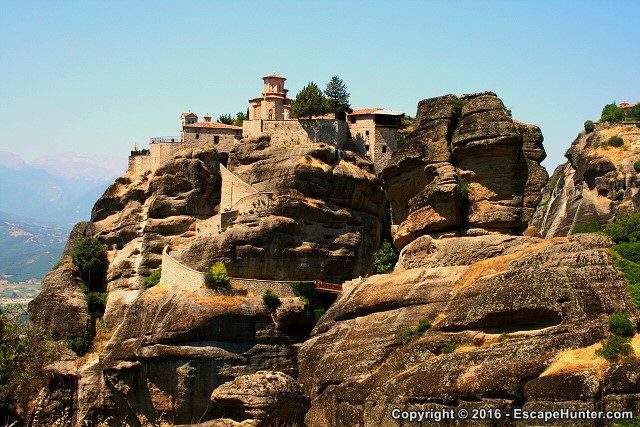
Varlaam Monastery is a short walk down from Great Meteoron
View Photo Gallery for more travel photos
How old are these monasteries?
The history of the Meteora monasteries dates back to 1344, when monk Athanasios Meteorites from Mount Athos first established a small church at the top of a cliff. Other facilities, extensions later followed...
But the ones I mention in this article are newer: built around the late 1480s onward into the 1500s.
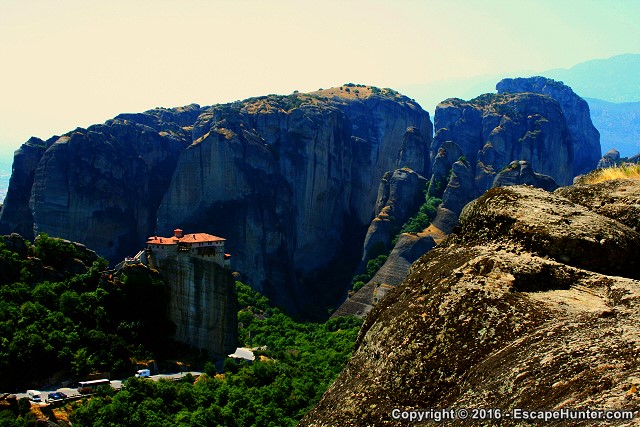
I took a longer walk down from Varlaam to reach Rousanou Monastery
View Photo Gallery for more travel photos
It still has to be mentioned that monks have been living in Meteora in the year 9 AD.
Great Meteoron is the oldest of the monasteries, built sometime around the 1300's. Though, many of these monasteries have undergone modifications and additions. Even during my 2009 summer visit, I saw entirely new buildings being constructed within the complexes (!).
There were many new additional elements built, but they blend in pretty well with what's old.
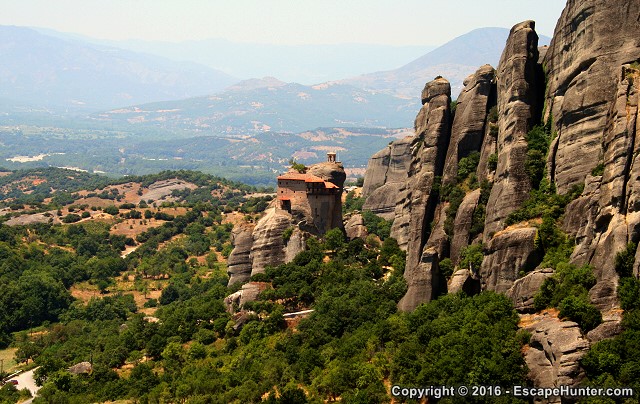
Monastery of Agios Nikolaos Anapafsas. I guess someone had to climb up there firt to put the first brick!
View Photo Gallery for more travel photos
The additions make the monasteries look "better". However, sometimes it may seem confusing to understand which part was built when...
As for the inhabitants: their vast majority is male, the only female-inhabited monastery is the nunnery of Agios Stefanos (seen on the picture below).
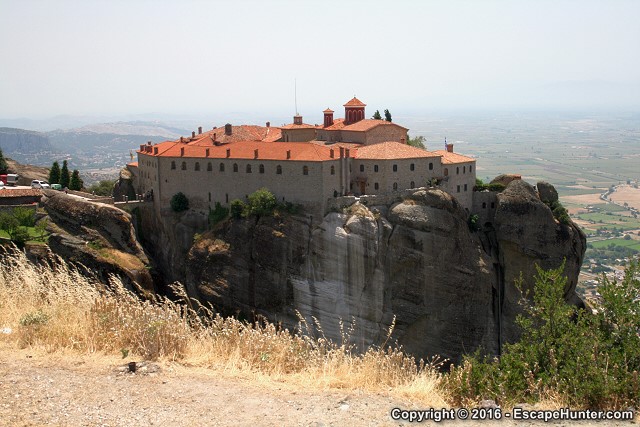
Agios Stefanos - this monastery was fired at by the Nazis in WW II
View Photo Gallery for more travel photos
Usually around a dozen-two dozen people live in either one of the monastery. Although, I believe their capacity allows to host around a 100 people.
Naturally, due to mass tourism, the monks and nuns aren't as isolated as they were 4-5 centuries ago.
The places are nice visiting, but I wouldn't want to live in either one of Meteora's monasteries.
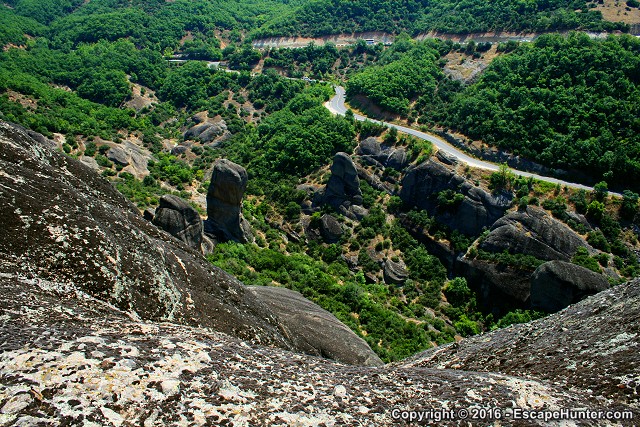
You can walk on the rounded cliffs, just be careful. One wrong step could be your last step!
View Photo Gallery for more travel photos
On my first day, I took the most visited monasteries one-by-one. They are located along the same road, so this was a good idea. I started the Grand Meteoron, but Varlaam was closed for visits...
As I was descending, walking at the edge of the road in boiling summer heat, I was contemplating the rounded boulders and cliffs scattered around me.
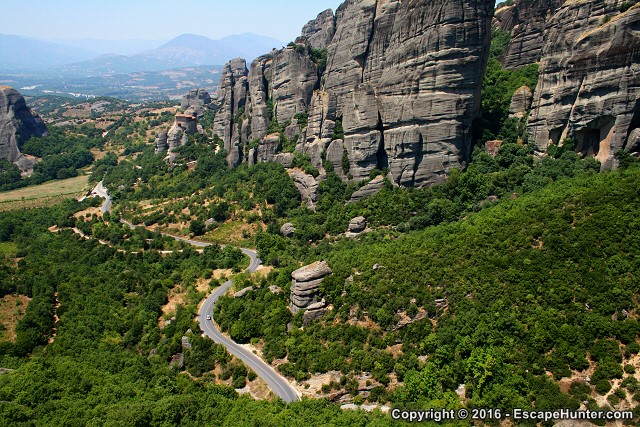
Like a grey snake, the road winds downwards to the town of Kastraki...
View Photo Gallery for more travel photos
I have strong reasons why I prefer wandering on foot, contemplating the shapes and colours around me and not take a tour bus and pay for an organized group trip (there are exceptions, of course.)
Besides the monasteries, I've found the entire natural environment of meteora very special.
You have to know that these are not volcanic rocks, but they were formed millions of years ago and are the result of wind-weathering and the friction with water (scientists say that rivers flowing into an immense ancient lake have contributed to the formation of the cliffs).
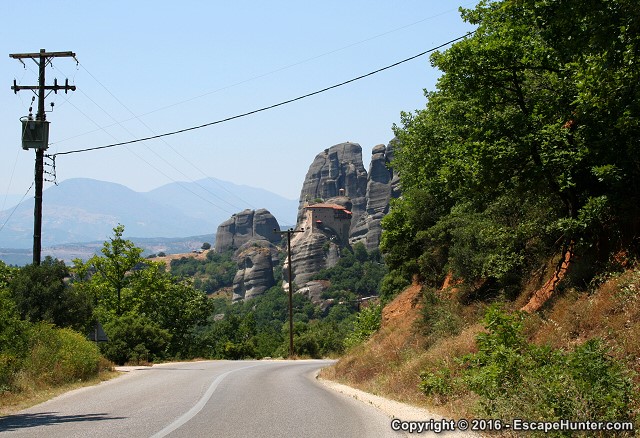
Walking in the sun... there's a long way to Kalambaka
View Photo Gallery for more travel photos

About the Author:
Escape Hunter, the young solo traveler in his early 30's explores the World driven by curiosity, thirst for adventure, deep passion for beauty, love for freedom and diversity.
With a nuanced, even humorous approach to travel, an obsession for art and design, Escape Hunter prefers to travel slowly, in order to learn and "soak up" the local atmosphere...
Comments

As "Escape Hunter" - the curious incognito traveler with an insatiable drive to explore, I embark on slow and deep travels around
our beautiful World.
Join me and I will show you exciting destinations
"from within", through my
"escape" trips!

Travel Slang Dictionary
Guide to my personal travel slang vocabulary, which seasons my content...






Stunning view, isn't it?